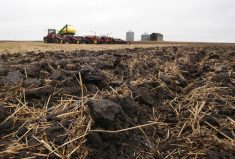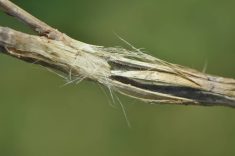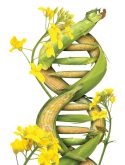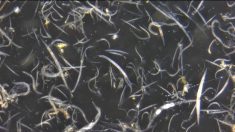The spotted-wing drosophila, a fruit-loving insect that attacks berries and tree fruits, has been detected in North Dakota for the first time.
It was discovered in a cherry fruit sample from the North Dakota State University Carrington Research Extension Center. The damaged fruit sample was submitted to the NDSU Plant Diagnostic Laboratory and identified by Patrick Beauzay, NDSU Extension Service entomologist.
The tiny spotted-wing drosophila belongs to the fruit fly or vinegar fly group. It is two to three millimetres long, and has bright-red eyes, a light-brown body and dark-brown stripes on its abdomen. It is native to Japan, Korea and China.
Read Also

Precision 4R cuts farm greenhouse gas emissions
Lower areas in your field tend to emit more greenhouse gas, research shows that precision 4R nutrient stewardship practices can help mute the trend
It first was detected in the U.S. in central California in 2008 and is now widespread in fruit-producing areas. This is the first confirmed record for North Dakota.
It was detected in western Montana in 2011 and southeastern Minnesota in 2012. Human-assisted transportation, rather than natural dispersion, most likely is the cause of its rapid spread because the spotted-wing drosophila does not fly far.
“The spotted-wing drosophila attacks fruit crops, including cherries, blueberries, raspberries, blackberries, peaches, nectarines, apricots and grapes,” says Janet Knodel, NDSU Extension entomologist. “Unlike native fruit flies, the spotted-wing drosophila does not require damaged fruit to infest. The female has a toothed, egg-laying structure that cuts a slit into healthy fruit and then lays eggs. Eggs hatch into larvae (worms) and then start feeding, which causes the fruit tissues to decay and rot.”
Monitoring and proper identification is important to determine if the insect is present. However, identification can be difficult because many native fruit flies resemble the spotted-wing drosophila and the insect is very small, so an examination under a microscope is necessary.
“For control, removing and destroying infested fruits and dropped fruits are the No. 1 defences against this serious fly pest,” Knodel says. “Chemical control can help reduce the fly populations and damaged fruits, but must be applied weekly or biweekly. Rotation of different classes of insecticides (modes of action) is very important to prevent the development of insecticide resistance.”


















